Microeconomic Analysis Homework: Market Structures and Analysis
VerifiedAdded on 2023/06/04
|6
|1030
|269
Homework Assignment
AI Summary
This document presents a comprehensive solution to a microeconomic analysis assignment, addressing key concepts such as market structures, including perfect competition and monopoly, and their implications on price, output, and resource allocation. The assignment explores the law of diminishing returns in the context of food production and examines the effects of online shopping apps on the retail market for electronics, considering consumer surplus and the profitability of traditional retailers. Furthermore, the solution analyzes the impact of government policy on the wool industry within a perfectly competitive market, considering both short-run and long-run effects. The assignment also delves into the transition from perfect competition to a monopoly, examining price discrimination and its impact on producer surplus and production levels. The analysis draws on economic principles and models, providing a detailed understanding of microeconomic concepts.
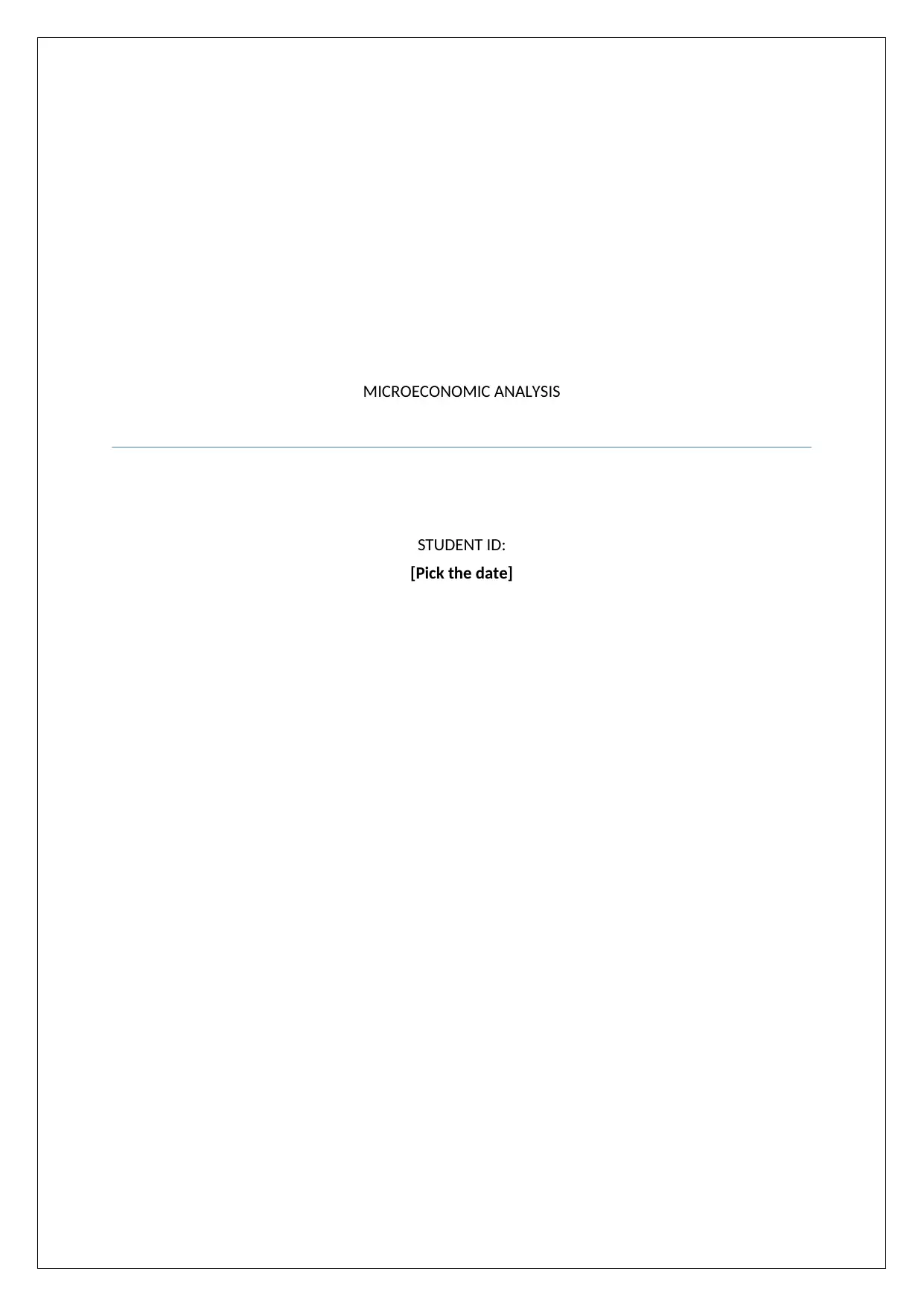
MICROECONOMIC ANALYSIS
STUDENT ID:
[Pick the date]
STUDENT ID:
[Pick the date]
Paraphrase This Document
Need a fresh take? Get an instant paraphrase of this document with our AI Paraphraser
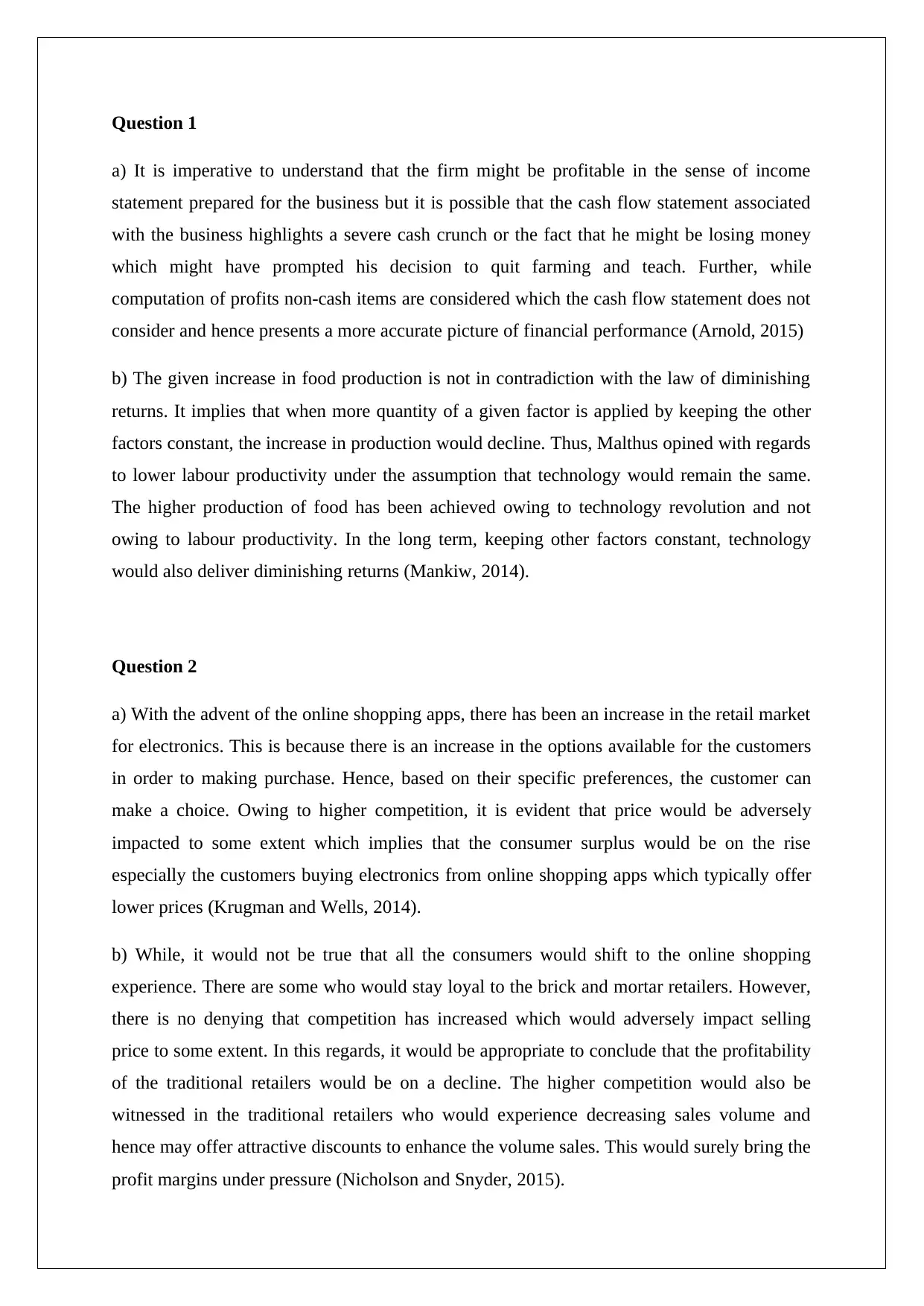
Question 1
a) It is imperative to understand that the firm might be profitable in the sense of income
statement prepared for the business but it is possible that the cash flow statement associated
with the business highlights a severe cash crunch or the fact that he might be losing money
which might have prompted his decision to quit farming and teach. Further, while
computation of profits non-cash items are considered which the cash flow statement does not
consider and hence presents a more accurate picture of financial performance (Arnold, 2015)
b) The given increase in food production is not in contradiction with the law of diminishing
returns. It implies that when more quantity of a given factor is applied by keeping the other
factors constant, the increase in production would decline. Thus, Malthus opined with regards
to lower labour productivity under the assumption that technology would remain the same.
The higher production of food has been achieved owing to technology revolution and not
owing to labour productivity. In the long term, keeping other factors constant, technology
would also deliver diminishing returns (Mankiw, 2014).
Question 2
a) With the advent of the online shopping apps, there has been an increase in the retail market
for electronics. This is because there is an increase in the options available for the customers
in order to making purchase. Hence, based on their specific preferences, the customer can
make a choice. Owing to higher competition, it is evident that price would be adversely
impacted to some extent which implies that the consumer surplus would be on the rise
especially the customers buying electronics from online shopping apps which typically offer
lower prices (Krugman and Wells, 2014).
b) While, it would not be true that all the consumers would shift to the online shopping
experience. There are some who would stay loyal to the brick and mortar retailers. However,
there is no denying that competition has increased which would adversely impact selling
price to some extent. In this regards, it would be appropriate to conclude that the profitability
of the traditional retailers would be on a decline. The higher competition would also be
witnessed in the traditional retailers who would experience decreasing sales volume and
hence may offer attractive discounts to enhance the volume sales. This would surely bring the
profit margins under pressure (Nicholson and Snyder, 2015).
a) It is imperative to understand that the firm might be profitable in the sense of income
statement prepared for the business but it is possible that the cash flow statement associated
with the business highlights a severe cash crunch or the fact that he might be losing money
which might have prompted his decision to quit farming and teach. Further, while
computation of profits non-cash items are considered which the cash flow statement does not
consider and hence presents a more accurate picture of financial performance (Arnold, 2015)
b) The given increase in food production is not in contradiction with the law of diminishing
returns. It implies that when more quantity of a given factor is applied by keeping the other
factors constant, the increase in production would decline. Thus, Malthus opined with regards
to lower labour productivity under the assumption that technology would remain the same.
The higher production of food has been achieved owing to technology revolution and not
owing to labour productivity. In the long term, keeping other factors constant, technology
would also deliver diminishing returns (Mankiw, 2014).
Question 2
a) With the advent of the online shopping apps, there has been an increase in the retail market
for electronics. This is because there is an increase in the options available for the customers
in order to making purchase. Hence, based on their specific preferences, the customer can
make a choice. Owing to higher competition, it is evident that price would be adversely
impacted to some extent which implies that the consumer surplus would be on the rise
especially the customers buying electronics from online shopping apps which typically offer
lower prices (Krugman and Wells, 2014).
b) While, it would not be true that all the consumers would shift to the online shopping
experience. There are some who would stay loyal to the brick and mortar retailers. However,
there is no denying that competition has increased which would adversely impact selling
price to some extent. In this regards, it would be appropriate to conclude that the profitability
of the traditional retailers would be on a decline. The higher competition would also be
witnessed in the traditional retailers who would experience decreasing sales volume and
hence may offer attractive discounts to enhance the volume sales. This would surely bring the
profit margins under pressure (Nicholson and Snyder, 2015).
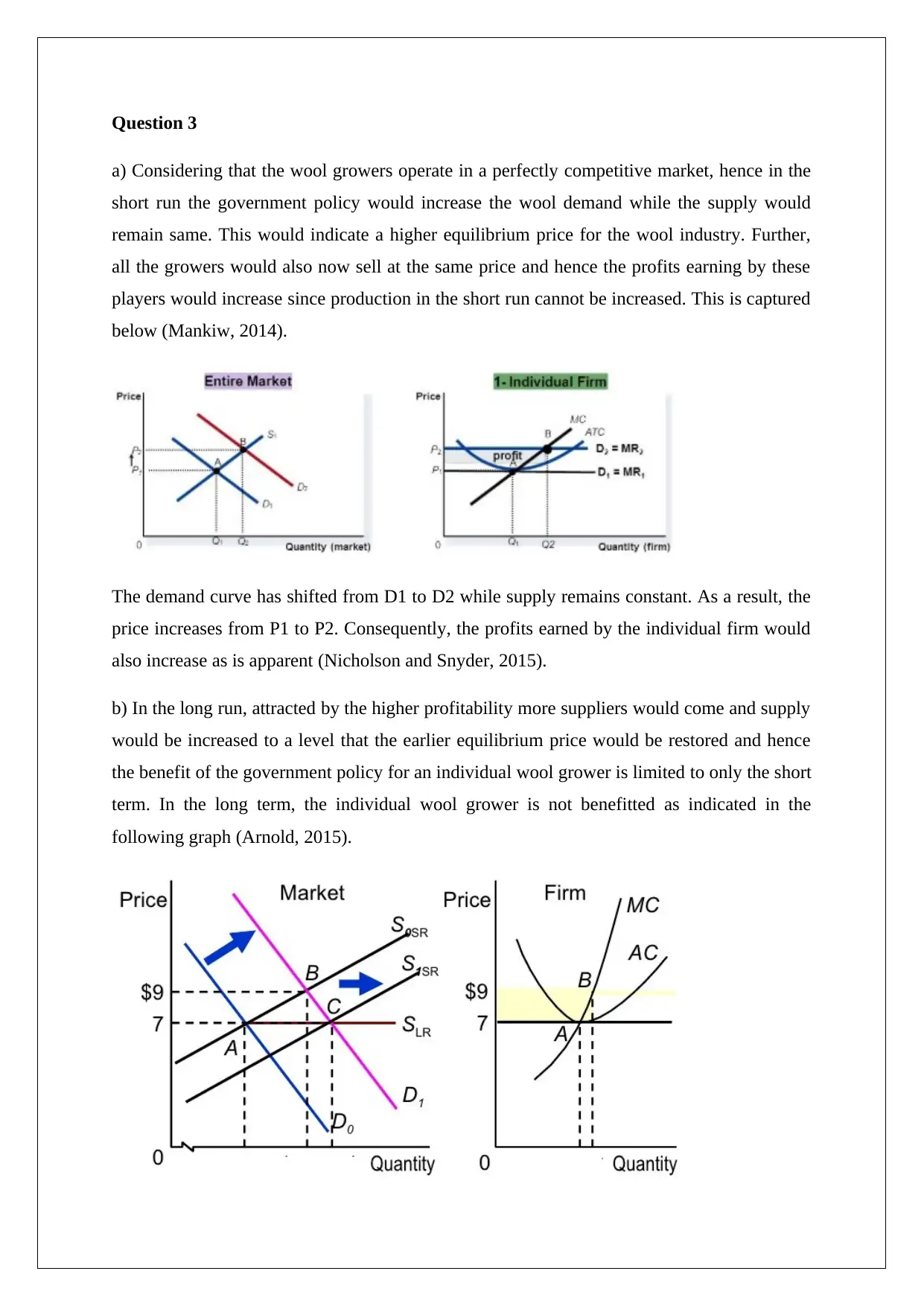
Question 3
a) Considering that the wool growers operate in a perfectly competitive market, hence in the
short run the government policy would increase the wool demand while the supply would
remain same. This would indicate a higher equilibrium price for the wool industry. Further,
all the growers would also now sell at the same price and hence the profits earning by these
players would increase since production in the short run cannot be increased. This is captured
below (Mankiw, 2014).
The demand curve has shifted from D1 to D2 while supply remains constant. As a result, the
price increases from P1 to P2. Consequently, the profits earned by the individual firm would
also increase as is apparent (Nicholson and Snyder, 2015).
b) In the long run, attracted by the higher profitability more suppliers would come and supply
would be increased to a level that the earlier equilibrium price would be restored and hence
the benefit of the government policy for an individual wool grower is limited to only the short
term. In the long term, the individual wool grower is not benefitted as indicated in the
following graph (Arnold, 2015).
a) Considering that the wool growers operate in a perfectly competitive market, hence in the
short run the government policy would increase the wool demand while the supply would
remain same. This would indicate a higher equilibrium price for the wool industry. Further,
all the growers would also now sell at the same price and hence the profits earning by these
players would increase since production in the short run cannot be increased. This is captured
below (Mankiw, 2014).
The demand curve has shifted from D1 to D2 while supply remains constant. As a result, the
price increases from P1 to P2. Consequently, the profits earned by the individual firm would
also increase as is apparent (Nicholson and Snyder, 2015).
b) In the long run, attracted by the higher profitability more suppliers would come and supply
would be increased to a level that the earlier equilibrium price would be restored and hence
the benefit of the government policy for an individual wool grower is limited to only the short
term. In the long term, the individual wool grower is not benefitted as indicated in the
following graph (Arnold, 2015).
⊘ This is a preview!⊘
Do you want full access?
Subscribe today to unlock all pages.

Trusted by 1+ million students worldwide
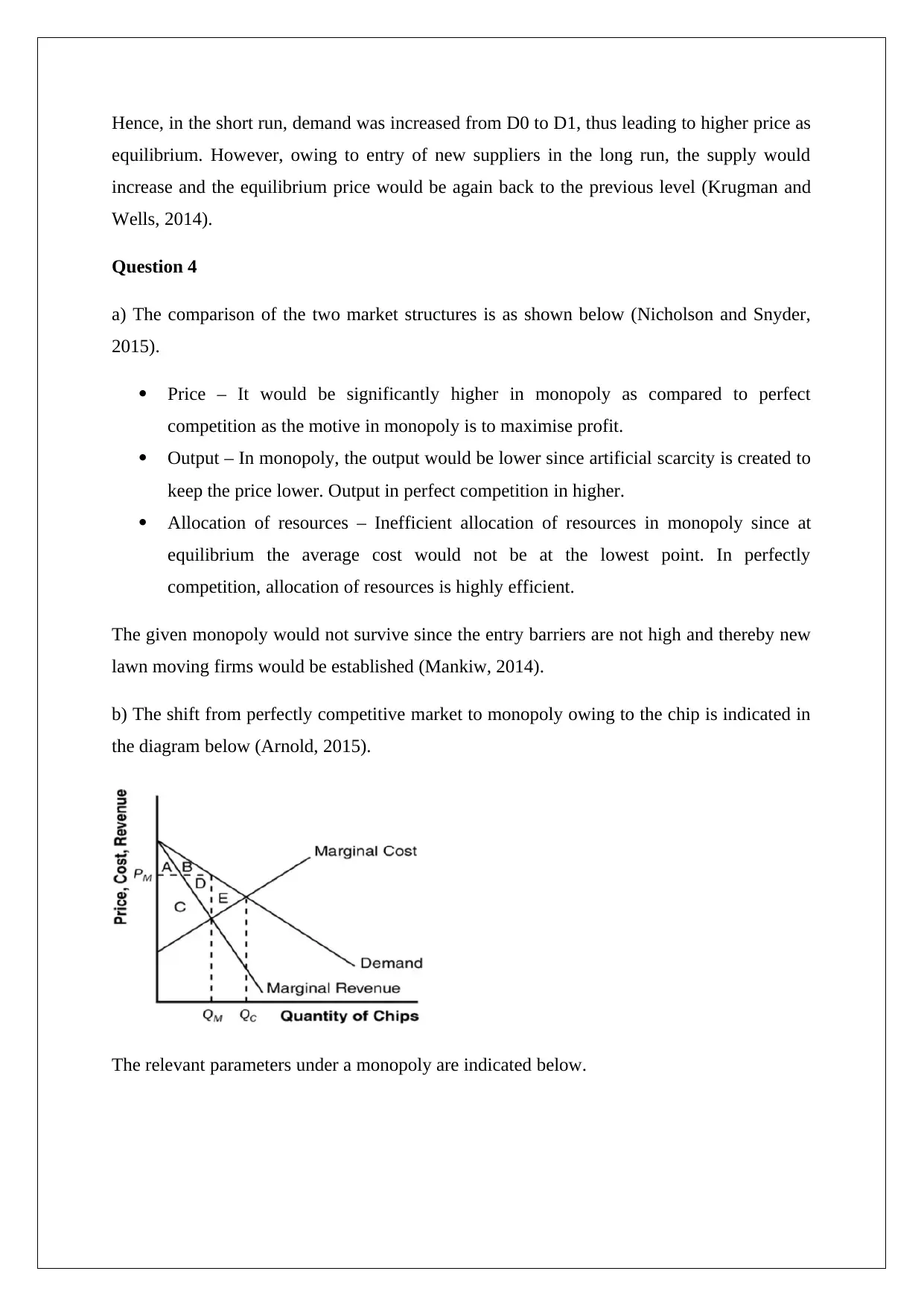
Hence, in the short run, demand was increased from D0 to D1, thus leading to higher price as
equilibrium. However, owing to entry of new suppliers in the long run, the supply would
increase and the equilibrium price would be again back to the previous level (Krugman and
Wells, 2014).
Question 4
a) The comparison of the two market structures is as shown below (Nicholson and Snyder,
2015).
Price – It would be significantly higher in monopoly as compared to perfect
competition as the motive in monopoly is to maximise profit.
Output – In monopoly, the output would be lower since artificial scarcity is created to
keep the price lower. Output in perfect competition in higher.
Allocation of resources – Inefficient allocation of resources in monopoly since at
equilibrium the average cost would not be at the lowest point. In perfectly
competition, allocation of resources is highly efficient.
The given monopoly would not survive since the entry barriers are not high and thereby new
lawn moving firms would be established (Mankiw, 2014).
b) The shift from perfectly competitive market to monopoly owing to the chip is indicated in
the diagram below (Arnold, 2015).
The relevant parameters under a monopoly are indicated below.
equilibrium. However, owing to entry of new suppliers in the long run, the supply would
increase and the equilibrium price would be again back to the previous level (Krugman and
Wells, 2014).
Question 4
a) The comparison of the two market structures is as shown below (Nicholson and Snyder,
2015).
Price – It would be significantly higher in monopoly as compared to perfect
competition as the motive in monopoly is to maximise profit.
Output – In monopoly, the output would be lower since artificial scarcity is created to
keep the price lower. Output in perfect competition in higher.
Allocation of resources – Inefficient allocation of resources in monopoly since at
equilibrium the average cost would not be at the lowest point. In perfectly
competition, allocation of resources is highly efficient.
The given monopoly would not survive since the entry barriers are not high and thereby new
lawn moving firms would be established (Mankiw, 2014).
b) The shift from perfectly competitive market to monopoly owing to the chip is indicated in
the diagram below (Arnold, 2015).
The relevant parameters under a monopoly are indicated below.
Paraphrase This Document
Need a fresh take? Get an instant paraphrase of this document with our AI Paraphraser
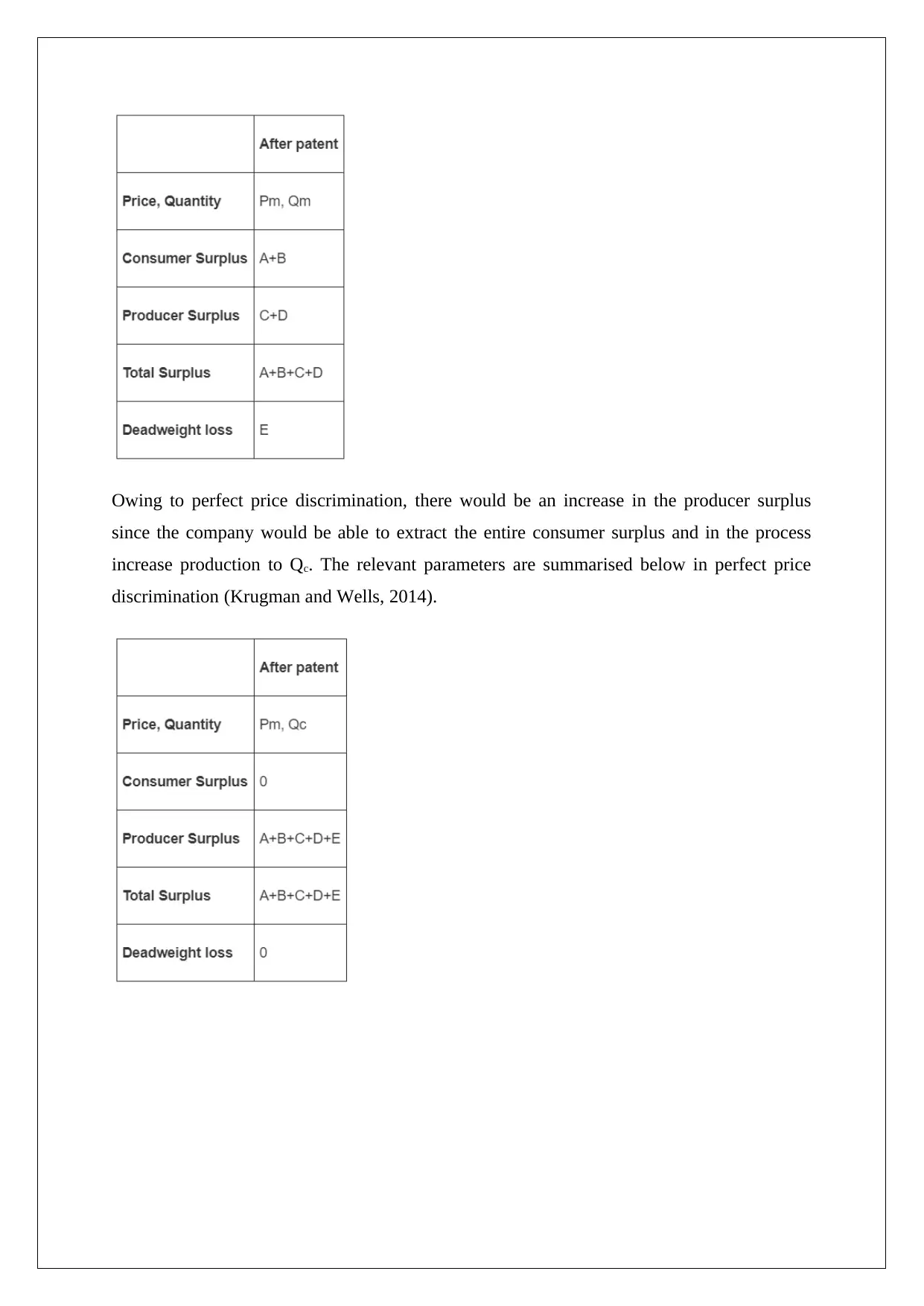
Owing to perfect price discrimination, there would be an increase in the producer surplus
since the company would be able to extract the entire consumer surplus and in the process
increase production to Qc. The relevant parameters are summarised below in perfect price
discrimination (Krugman and Wells, 2014).
since the company would be able to extract the entire consumer surplus and in the process
increase production to Qc. The relevant parameters are summarised below in perfect price
discrimination (Krugman and Wells, 2014).
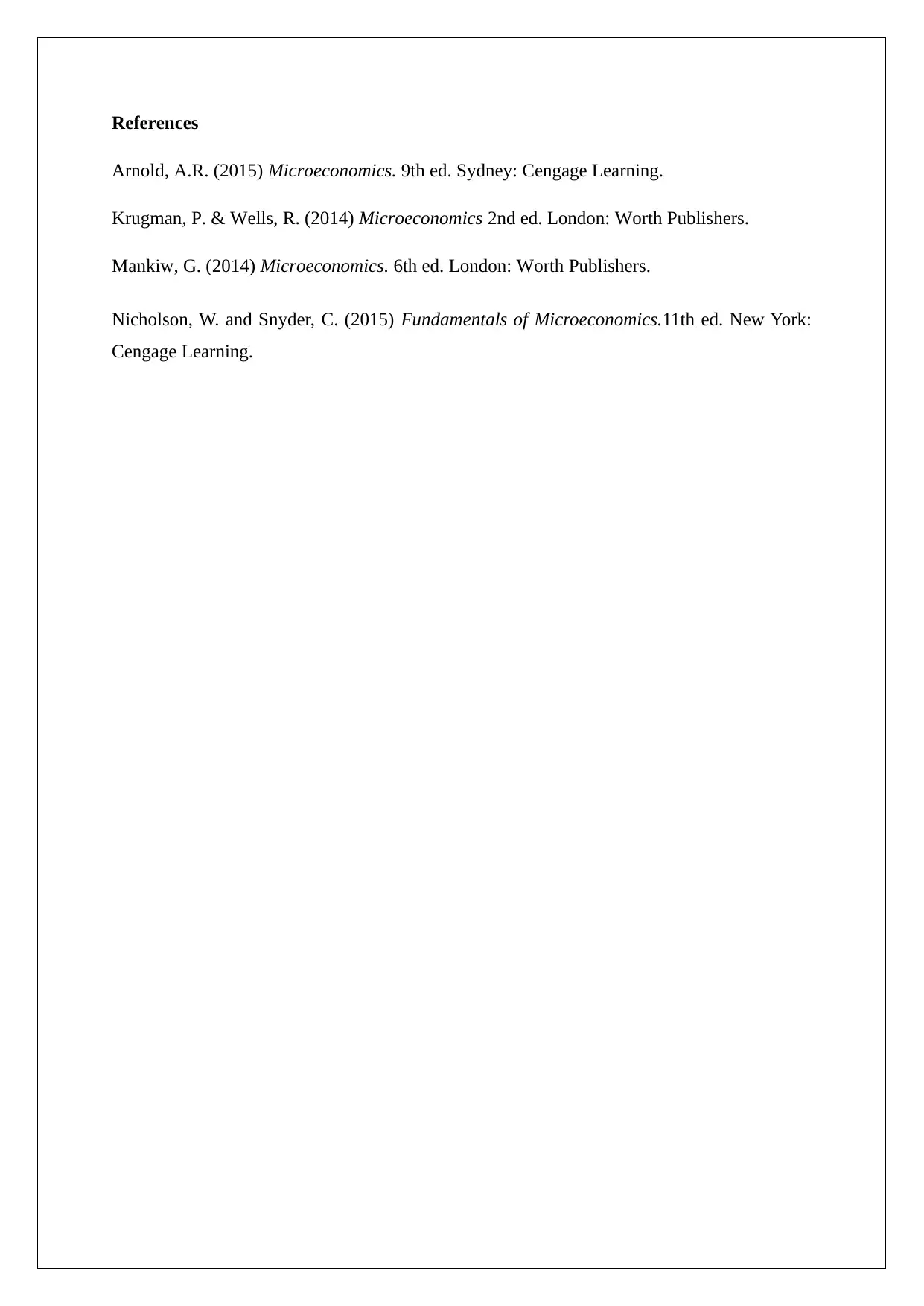
References
Arnold, A.R. (2015) Microeconomics. 9th ed. Sydney: Cengage Learning.
Krugman, P. & Wells, R. (2014) Microeconomics 2nd ed. London: Worth Publishers.
Mankiw, G. (2014) Microeconomics. 6th ed. London: Worth Publishers.
Nicholson, W. and Snyder, C. (2015) Fundamentals of Microeconomics.11th ed. New York:
Cengage Learning.
Arnold, A.R. (2015) Microeconomics. 9th ed. Sydney: Cengage Learning.
Krugman, P. & Wells, R. (2014) Microeconomics 2nd ed. London: Worth Publishers.
Mankiw, G. (2014) Microeconomics. 6th ed. London: Worth Publishers.
Nicholson, W. and Snyder, C. (2015) Fundamentals of Microeconomics.11th ed. New York:
Cengage Learning.
⊘ This is a preview!⊘
Do you want full access?
Subscribe today to unlock all pages.

Trusted by 1+ million students worldwide
1 out of 6
Related Documents
Your All-in-One AI-Powered Toolkit for Academic Success.
+13062052269
info@desklib.com
Available 24*7 on WhatsApp / Email
![[object Object]](/_next/static/media/star-bottom.7253800d.svg)
Unlock your academic potential
Copyright © 2020–2025 A2Z Services. All Rights Reserved. Developed and managed by ZUCOL.





